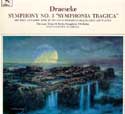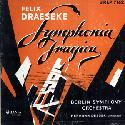| Felix Draeseke: Symphony No. 3 in C major "Symphonia tragica," Op. 40 Varese Sarabande VC81092 [Mono LP - Released 1979; out of print] Urania URLP-7162 [Mono LP - Released 1955; out of print] Berlin Symphony Orchestra conducted by Hermann Desser (a.k.a. Heinz Drewes).
[Home] |
Notes from the Original LP Release of the Symphonia Tragica Side
One I.
First Movement: Andante - Allegro risoluto Side
Two I.
Third Movement: Scherzo, Allegro molto vivace Berlin
Symphony Orchestra Although the name of Felix Draeseke (1835-1913) is not too well known today, he enjoyed great popularity in the latter part of the 19th century and won the admiration of such distinguished musicians as Franz Liszt, Brahms, Hans von Bulow, Peter Cornelius and Carl Tausig. Born at Coburg, Oct. 7, 1835, a graduate of the Leipzig Conservatory and a Liszt pupil in Weimar, Draeseke was considered a rather eccentric radical in his youth, becoming an active member of the group known as the "New German School". He taught piano, harmony and composition in Lausanne, Geneva and Munich, eventually succeeding Franz Wullner at the Dresden Conservatory, where he attained the title of Hofrath in 1898. By that time Draeseke had mellowed into a fairly conservative composer of the Romantic school, technically brilliant but by no means heretical by modern standards. His earliest works were for the piano, including several waltzes and an excellent sonata. Later he wrote four operas, for the first of which he also supplied the libretto. His three symphonies, of which the "Tragic" is the third and considered best, bear the opus numbers 12, 25 and 40. Draeseke also composed several overtures (with such titles as Penthesilea, Jubilee and Academic Festival), a Serenade, three Symphonic Preludes, Concertos for violin, cello, and such choral works as the Easter Scene from Faust, a Requiem, a Grand Mass, Christus, and Columbus. As a writer on musical subjects he is credited with a significant analysis of the Liszt Symphonic Poems, an essay on Peter Cornelius, several treatises on creative technique and a rhymed book on Harmony. The Tragic Symphony This work, definitely the most important of Draeseke's orchestral compositions, was written in Dresden in 1886. It was published by Kistner of Leipzig in October, 1887, and premiered by Ernst Schuch, conducting the orchestra of the Royal Chapel. The Berlin Philharmonic Orchestra gave the symphony two more performances the same year (Dec. 10 and 11) under the baton of Hans von Bulow, one of Draeseke's greatest friends and admirers. The instrumentation is of the conventional symphonic type, but used with a masterly technique throughout the four movements. The symphony begins with an Andante introduction, portentous in its heavy octaves and dramatic minor chords. The major part of the first movement is marked Allegro risoluto. A lyric passage in the strings, still in minor key, is followed by a melodious theme, introduced by the wind instruments over a simple string accompaniment. There is immediate development of this material, reaching a climax of triumphant song by the full orchestra. A brief interlude by the horns and solo cello leads to a new theme in the strings, suggesting a free adaptation of the traditional sonata form. The development is interesting, and the recapitulation includes a climactic reminder of the first theme in sonorous instrumentation. Fanfares are heard in the brass toward the close. This opening movement illustrates many of the details of Draeseke's resourceful technique. He is fond of using short phrases at various levels of pitch, foretelling the individual style developed later by Sibelius. He often harmonizes two related instruments a third apart, creating pleasant duet effects, and occasionally indulges in touches of canon, imitation and fugato. The second movement of the "Tragic Symphony" (Grave; Adagio ma non troppo) starts quietly in the horns. Then the strings voice a beautiful slow melody, at first reminiscent of the Lenten chorale in Bach's St. Matthew Passion. There is a yearning quality in the minor chords that acts as a connecting link with another explosion of the brass choir in portentous, almost menacing mood. The woodwind and strings provide a contrast, and the development is full of clever devices of imitation and decoration. As the full orchestra intones the main theme, the symphony seems to live up to its title, almost suggesting a definite program in the composer's mind. There are Brahmsian effects, with protesting short phrases by the violins, and a Wagnerian influence is also apparent, including a brief quotation almost directly out of Tannhauser. With gradually softening fanfares and sudden changes from minor to major, the slow movement ends quite softly, in apparent resignation. The third movement is a Scherzo, Allegro molto vivace. There is an immediate fast theme in triple time, suggesting a round dance and full of syncopation. The second theme is more plaintive, but still melodious and with a lush orchestration that displays the individual players to the best possible advantage. The composer returns to a fairly straight reminder of the first theme, with touches of pizzicato, turning Poldini's Dancing Doll upside down, as it were, and using a melodic and rhythmic pattern employed by Arthur Sullivan in his Gondoliers' Cachucha a few years later. This Scherzo movement ends suddenly with a repetition of its first theme. The Finale (Allegro con brio) starts with introductory wanderings by the strings, with a questioning suggestion of the slow theme of the second movement. Then Draeseke goes into another lively tune in triple time, slightly reminiscent of the Scherzo and given some immediate development. A slow interlude builds up again to the lilting theme in triplets, followed by a short fugato in dance rhythm. There is a rather involved development of essentially simple materials, with emphasis on the instrumentation, which at times suggests that of Tchaikovsky at his best. (There are echoes also of Beethoven's Scherzo in the ninth symphony and further precursors of the Sibelius technique in the use of short phrases.) Finally there is a reminder of the chief theme of the first movement (unconsciously imitated by Richard Strauss in his Rosenkavalier duet) and the end is very quiet and resigned, with a last C major chord re-establishing the key of the entire symphony. - Sigmund Spaeth - Notes from the original Urania release and reprinted by Varese-Sarabande. Webmaster's note: Sigmund Spaeth's notes are reproduced here only to complete documentation of the Desser (Drewes) recording. Spaeth exhibits a lack of acquaintance with the music from either use of the score or any previous encounter; comments regarding the music are essentially useless. |
|
[Home] [About IDG] [Discography] [Links] [Draeseke's Compositions] [Resources] [AKCoburg Recordings] [Biography] [Music Samples] © All contents copyright by the IDG, IDS/NA |

